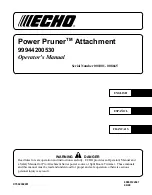
When AC power is applied, the charging indicator light is illuminated, indicating that the battery is being charged.
When power fails, the emergency ballast automatically switches to emergency power (internal battery), providing at
least 90 minutes of emergency lighting.
Although no routine maintenance is required to keep the emergency ballast functional, it should be checked
periodically to ensure that it is working. The following schedule is recommended:
1. Visually inspect the charging indicator light monthly. It should be illuminated.
2. Test the emergency operation of the fixture at 30-day intervals for a minimum of 30 seconds. One lamp
should operate at reduced illumination.
3. Conduct a 90-minute discharge test once a year. One lamp should operate at reduced illumination for at least
90 minutes.
! REFER ANY SERVICING INDICATED BY THESE CHECKS TO QUALIFIED PERSONNEL !
STEP #3
EMERGENCY BALLAST QUICK CHECK AND LABELING
> For short-term testing of the emergency function, the battery must be charged for at least two hours. The
emergency ballast must be charged for at least 24 hours before conducting a long-term test.
> In a readily visible location, attach the label "CAUTION: This Unit Has More Than One Power Supply Connec-
tion Point. To Reduce The Risk Of Electric Shock, Disconnect Both The Branch Circuit-Breakers Or Fuses And
Emergency Power Supplies Before Servicing."
OPERATION
MAINTENANCE
3






















